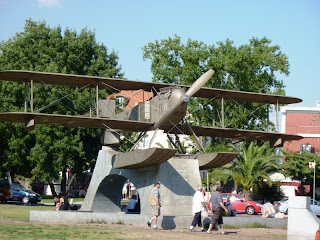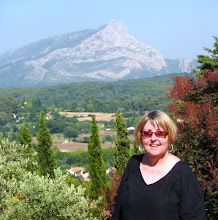There were many things to see (and eat) in Belem. This post deals with a number of them and the next one will concentrate on the major attraction, the monastery.
We took the subway/commuter train, got off in Belem and walked directly to one of the most famous places in Portugal to get the traditional egg custard Pasteis (pastry). As you can see from the sidewalk, this cafe has been there awhile.
Roughly translated, this tile sign on the wall says, "Rest on the way to the holy temple on the seashore of the place named for the land where God in the flesh was given to the world", i.e., Bethlehem.
This says that the house (restaurant/cafe) was founded in 1837. The link will take you to some history about Pasteis de Belem.
Tile is abundant here, but these pieces were particularly protected. They were also directly in front of the table where we sat.
This was the tile on the wall right next to us.
The tile formed a wainscot on all the walls. People kept coming in the door to the restaurant part and standing right in front of us looking and waiting for a table. I started asking them if they spoke English, and if they did, I pointed out that there were lots of tables through the open doorways.
Gradually people started going farther back and finding rooms like this. The place was enormous.
The kitchen's tile went up higher on the walls.
Many people just line up at the take-out door, get their pastries and eat them outside.
They make thousands of these little egg custards every day.
We had lunch and pasteis for dessert along with some coffee and then started walking. We went to the monastery first (next posting), then took the bus farther away to see some more famous sites along the Tagus River.
Built in the early 16th centure, the Belem Tower served as both a line of defence and a gateway to Lisbon on the Tagus.
We were not sure what this building is, but it is right where the Tagus goes into the Atlantic. We guessed that it might have something to do with producing tidal energy, but I couldn't find anything specific about it.
The park along the river is lovely with lots of trees in some places. We took advantage of those to take an ice cream break.
Trout liked this bi-plane monument.
This is a little bridge over the tracks of the train we were on.
Trout was fascinated by the locations of these gas pumps.
There is a marina to the right of those gas pumps. The water was clear enough for me to see fish feeding on the algae of its wall.
They were impressive until we got back on the path along the Tagus. These guys were a little bigger. They were hanging out by some kind of effluent pipe. Whatever was coming out definitely attracted them.
This bridge across the Tagus is called the 25th of April Bridge. It's often compared to the Golden Gate and was built by the American Bridge Company that built the Oakland Bay Bridge. The name comes from the date the Carnation Revolution started in 1974. That was a military coup in which no shots were fired and which changed Portugal from a dictatorship to a democracy. The name comes from the fact that people celebrated the end of the war in the colonies by putting carnations in the guns of the soldiers and on their uniforms. It was the 70's, you know.
This has gotta be some kind of energy producing thing, right?
Besides the monastery, and the pasteis shop, this has got to be the most popular site in Belem. Built in 1960, the Discoveries Monument commemorates the 500th anniversary of the the death of Prince Henry the Navigator, but includes references to other Portuguese explorers including Vasco de Gama and Magellan.
The plaza in front of it has more of that wavy cobbleston design.
Of particular interest to me was this large depiction of Portugues explorations. There were so many people around and standing on it, I barely got a couple of decent pictures. I concentrated on the Americas.
Although most paving we saw in Portugal had the large blocks, this area of the park between the monatery and the monument used smaller stones.
The driver didn't know where it was either, so I called the restaurant again, gave him my cell phone and they talked him to their door, although he passed it and had to turn around and go back. It turned out to be only about a block from where we gave up walking the first time before turning back. And it was a good 6 or more blocks from the monastery. So if you are looking for this place, don't believe the maps if they show it right next to the monastery. It's on the same main street, but much farther away.
I won't depend on Fodor's or Frommer's or whatever map it was again, but I'm glad we found it. The food was excellent, and it was served family style. Like most Americans, we were there a bit early, but by the time we got our food, the place was full. It was good we got there early because we didn't have reservations.
They had the typical lobsters in the tank, but I liked the seafood on ice. The items on the right are a Portuguese delicacy -- barnacles. They are very expensive. We didn't have any.
The crabs were huge. It wasn't the case with what I got (some small fried fish) or what Trout got (a stew with shrimp), but many of the seafood options on Portuguese menus are priced by how much you get. The menu will usually give the price for a kilo and you can figure out the cost from that for how much you want.
We felt a lot better after eating, so we walked back to the train station and began our journey home to our apartment. It was a typically full sightseeing day and we were pooped. It was great to come "home" and settle in for the night.































